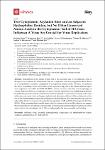Two Cytoplasmic Acylation Sites and an Adjacent Hydrophobic Residue, but No Other Conserved Amino Acids in the Cytoplasmic Tail of HA from Influenza A Virus Are Crucial for Virus Replication
Siche, Stefanie
Brett, Katharina
Möller, Lars
Kordyukova, Larisa V.
Mintaev, Ramil R.
Alexeevski, Andrei V.
Veit, Michael
Recruitment of the matrix protein M1 to the assembly site of the influenza virus is thought to be mediated by interactions with the cytoplasmic tail of hemagglutinin (HA). Based on a comprehensive sequence comparison of all sequences present in the database, we analyzed the effect of mutating conserved residues in the cytosol-facing part of the transmembrane region and cytoplasmic tail of HA (A/WSN/33 (H1N1) strain) on virus replication and morphology of virions. Removal of the two cytoplasmic acylation sites and substitution of a neighboring isoleucine by glutamine prevented rescue of infectious virions. In contrast, a conservative exchange of the same isoleucine, non-conservative exchanges of glycine and glutamine, deletion of the acylation site at the end of the transmembrane region and shifting it into the tail did not affect virus morphology and had only subtle effects on virus growth and on the incorporation of M1 and Ribo-Nucleoprotein Particles (RNPs). Thus, assuming that essential amino acids are conserved between HA subtypes we suggest that, besides the two cytoplasmic acylation sites (including adjacent hydrophobic residues), no other amino acids in the cytoplasmic tail of HA are indispensable for virus assembly and budding.
Dateien zu dieser Publikation
Keine Lizenzangabe

